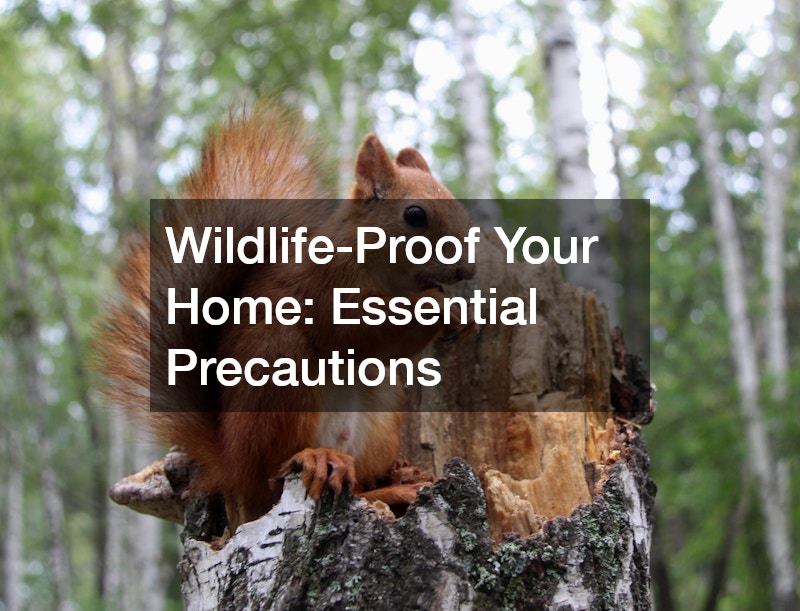This article provides comprehensive guidance on wildlife prevention and how to wildlife-proof your home, ensuring both the safety of your household and the well-being of local wildlife. By taking proactive measures, you can prevent unwanted encounters and potential damage to your property. Creating a safe boundary between your living space and the natural world is essential for maintaining peace and security.
Additionally, implementing these preventative steps can help protect your home from costly repairs and minimize the risk of attracting dangerous animals.
How can I identify and seal potential entry points in my home?
Conducting a thorough inspection of your home’s exterior is paramount to preventing wildlife intrusion. Begin by checking the foundation for cracks or holes, as these can serve as entry points for small animals. Additionally, ensure that vents, chimneys, and attic spaces are properly covered with appropriate materials.
Don’t overlook the importance of maintaining the integrity of your home’s interior structure. Look closely at door frames and window seals for any gaps that could potentially allow wildlife access. Remember, even a small opening can invite unwelcome guests, so use weather stripping or caulk to seal these areas efficiently.
Consistently reaffirming the security of your home by inspecting these key areas significantly reduces the likelihood of wildlife intrusions. Make it a routine to check your home at the change of each season, as weather can often exacerbate existing vulnerabilities. Fixing problems as they arise will prevent future issues and safeguard against wildlife entry.
What are the best practices for managing food and waste to deter wildlife?
Properly managing food storage is crucial to deterring wildlife from being drawn to your property. Always keep edible items in airtight containers to prevent odors from escaping and piquing wildlife’s interest. Consider investing in durable rubber or metal bins for added security against determined animal intruders.
Waste management requires careful attention to minimize wildlife attraction. Ensure trash cans have tightly fitting lids and are stored in a secure location, particularly during nighttime hours when animals are most active. Composting should be done with enclosed bins that offer no opportunity for wildlife access.
Always remember that effective waste management is a proactive shield against potential wildlife problems. Regularly clean your trash areas to reduce lingering odors and prevent build-up that can draw animals. By adhering to these practices, you create a less appealing environment for wildlife, keeping your property and its surroundings safe and clean.
Which landscaping strategies can help prevent wildlife encroachment?
Thoughtful garden design plays an integral role in discouraging wildlife encroachment onto your property. Choosing the right plants can deter animals from considering your yard as a food source; for instance, opt for unpalatable species that are less attractive to common intruders like deer or rabbits. Strategic plant placement can also guide wildlife away from more vulnerable areas of your home, directing them toward less hospitable zones.
Maintaining tidy landscaping is another key strategy in prevention. Regularly trim bushes and trees to eliminate hiding spots and potential nesting sites for animals. It’s also beneficial to remove fallen fruit, nuts, and other debris promptly, as these could serve as easy food sources for wildlife, inviting unwanted guests. Keeping your yard clean of compost piles and organic waste reduces the chances of attracting critters looking for a meal.
Consider implementing physical barriers such as fences or natural deterrents like gravel or thorny shrubs to create additional obstacles for wildlife seeking entry. These features not only enhance your property’s security but also contribute aesthetically to your landscape design, adding texture and variety. For extra protection, opt for taller fences or those with buried bottoms to prevent animals from burrowing underneath. By integrating these strategies, you establish a formidable defense against unwanted wildlife interactions, creating an environment where both your home and the natural world can peacefully coexist.
By implementing these essential precautions, you can create a wildlife-proof environment that protects both your home and local wildlife. These strategies will not only prevent nuisances but also contribute to maintaining a harmonious balance between human habitation and nature. Investing time and resources into wildlife-proofing your home ensures long-term peace and security for your family and fosters a respectful coexistence with the natural world. Additionally, these efforts can reduce the likelihood of costly repairs and enhance the overall well-being of your community by protecting local ecosystems.
.



